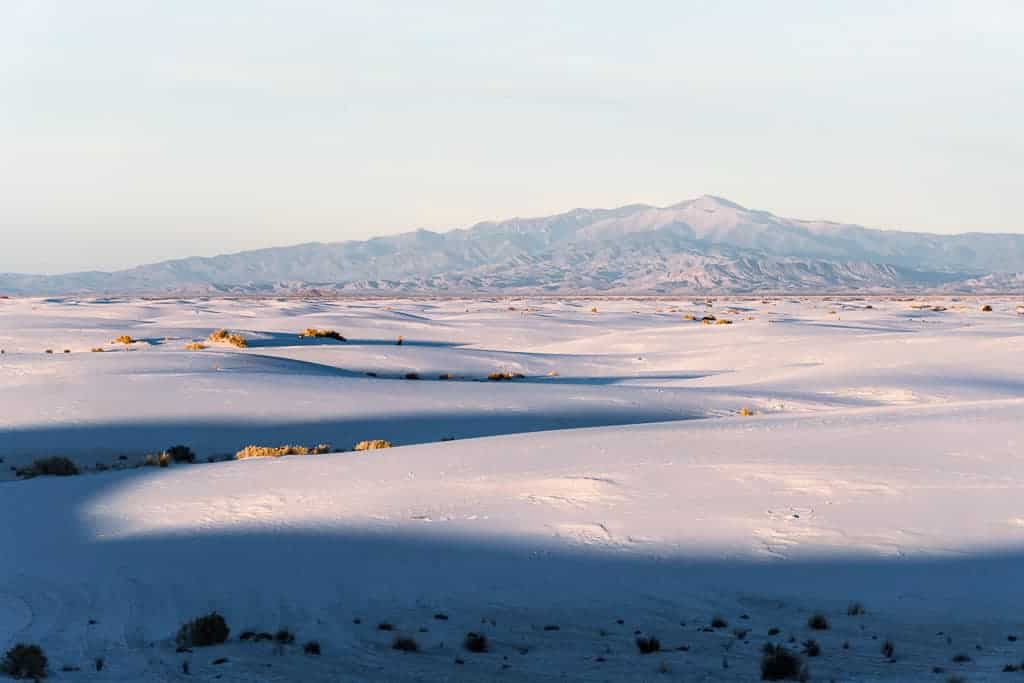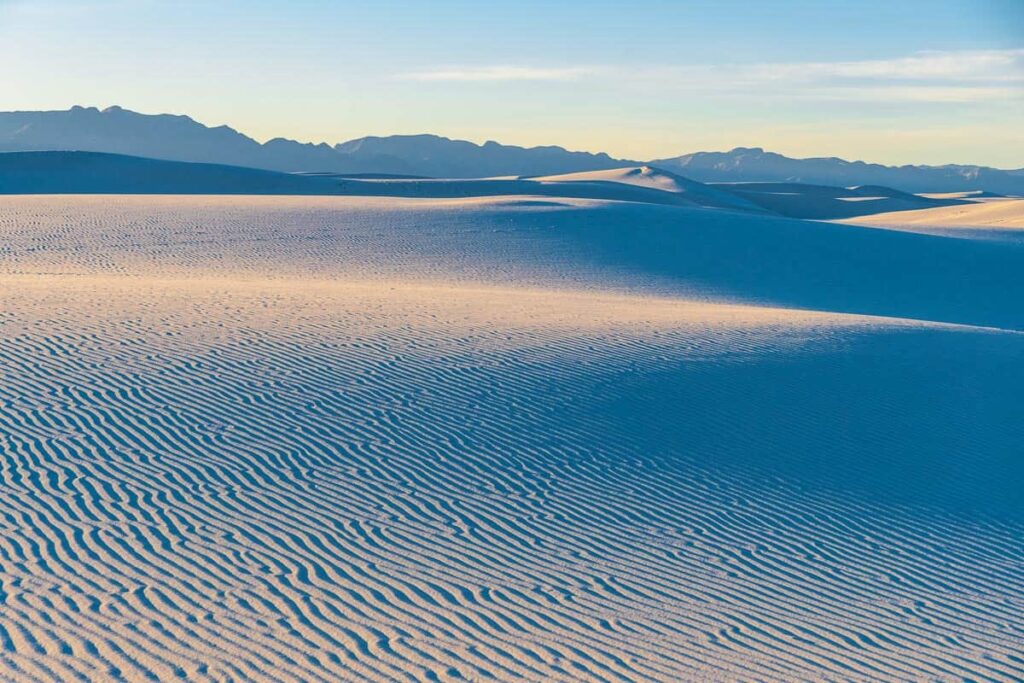Why Now Is The Best Time To Visit The World’s Largest Gypsum Dune Field

White Sands National Park, a true gem of the American Southwest, draws visitors from across the globe with its stunning gypsum dunes that stretch as far as the eye can see. On my own 5-month road trip, I arrived at this Southern New Mexico national park during the prime time of late fall, which was incredible all day, not too crowded, and just minorly chilly in the evenings.
Weather at White Sands National Park can vary from scorching summers to chilly winters. So, here’s a quick look at the tourist seasons at White Sands:
- Peak Season: October to May
- Shoulder Seasons: March to May and September to November
- Off-Peak Season: June to September
Below, I will also share details of the seasons, any events you don’t want to miss, and a monthly weather breakdown. Whether you’re going to the White Sands for a day or a whole week, these are the best times to visit White Sands National Park to help plan your trip.

Best Time to Visit White Sands National Park
Best Season to Visit
The best time to visit White Sands National Park is generally between October and May, but especially during spring and fall. During this period, the park enjoys mild weather conditions, allowing visitors to comfortably explore the vast gypsum dunes and challenging trails like the Alkali Flat Trail without the discomfort of intense heat. Plus, the softer light in these months makes the gypsum dunes appear even more photogenic.
Best Time for Good Weather
The optimal time for the most pleasant weather at White Sands National Park is between October and May. During these months, the scorching desert sun is replaced with mild temperatures, typically ranging from 60 to 80 degrees Fahrenheit, ideal for outdoor activities like hiking or dune sledding. The park is truly a spectacle during this period, with the gypsum dunes glistening under the clear, blue skies.
Best Time for Smaller Crowds
The best time for smaller crowds is during the shoulder seasons, right before and after summer. The park tends to see fewer visitors due to a combination of factors, including school schedules, non-holiday periods, and intense temperatures. It’s not uncommon during these times to find yourself sharing the vast expanse of the park with just a handful of other people.
Best Time for Lower Prices
The cheapest time to visit is during the off-peak season, from June to September. During this time, the intense summer heat tends to deter a majority of tourists, leading to a drop in accommodation prices around the area, often to the tune of 20-30% off peak rates.
Worst Time to Visit
The worst time to visit White Sands National Park is during the peak of summer, from late June to August. The searing desert heat can reach up to 100 degrees Fahrenheit during these months, making outdoor activities uncomfortable and potentially hazardous due to heat exhaustion. Moreover, the intense sun can cause the gypsum dunes to heat up, making them too hot to walk on barefoot.

Seasons at White Sands National Park
White Sands National Park experiences four distinct seasons.
Spring (March to May)
Spring in White Sands National Park welcomes an even milder climate than the relatively mild winters, with temperatures averaging between 60°F and 80°F.
The landscape comes alive with desert flora, creating a beautiful contrast against the stark white gypsum. However, the high winds common during this season can result in reduced visibility due to blowing sand.
Spring is a popular time for visitors, especially for photography, capturing the combination of blooming flowers against the surreal white background.
Summer (June to August)
Summer in White Sands National Park is harsh and arid. Daytime temperatures can soar to over 100°F, making outdoor activities at the height of the day quite daunting. Plus, the heat of the day makes the sand so hot that it’s hard to hike on the dunes.
The early mornings and late evenings are the only relief from the scorching heat. Despite this, summer brings with it an explosion of color as desert flora like the soaptree yucca and night-blooming cereus come into bloom. Nocturnal creatures such as kit foxes and kangaroo rats, also venture out in the cooler hours.

Fall (September to November)
Fall is an ideal time to visit White Sands National Park. With the extreme summer heat subsiding, temperatures comfortably range between 70°F and 85°F. There’s also a sharp decrease in the number of visitors post-Labor Day.
Fall is the time for the park’s annual event, the White Sands Balloon and Music Festival, where hot air balloons fill the clear blue sky above the dunes.
You may catch the “white wave” phenomenon caused by strong winds blowing against the dunes. The “white wave” happens when strong winds create the illusion of a massive, flowing wave across the stark white gypsum dunes.
Winter (December to February)
It does actually snow at White Sands, with the gypsum dunes sometimes blanketed under another layer of whiteness. Temperatures during this season can drop to as low as 20°F at night, while daytime highs remain comfortably in the mid-50s.
The park’s skies largely remain clear and sunny, but the crowd is significantly thinner.

White Sands Weather by Month
Here is a month-by-month breakdown of the average high and low temperatures and precipitation at White Sands National Park:
| Month | Average High Temperature (°F) | Average Low Temperature (°F) | Average Precipitation (inches) |
|---|---|---|---|
| January | 57 | 22 | 0.60 |
| February | 63 | 27 | 0.39 |
| March | 71 | 32 | 0.27 |
| April | 79 | 40 | 0.29 |
| May | 88 | 50 | 0.49 |
| June | 97 | 59 | 0.89 |
| July | 97 | 64 | 1.41 |
| August | 94 | 62 | 2.07 |
| September | 89 | 55 | 1.44 |
| October | 79 | 41 | 1.09 |
| November | 67 | 28 | 0.68 |
| December | 57 | 21 | 0.79 |
Best Time of Day to Visit
The ideal time of day to visit White Sands National Park is late afternoon to early evening. This timeframe is when the magical transformation of the setting sun casts long shadows and paints the gypsum dunes in hues of pink and purple – a photographer’s dream come true. It’s also cooler, so your dune sledding or hiking adventures are more comfortable.
A Time-of-Day Breakdown at White Sands National Park
- Morning (7 am – 11 am): Mornings at the park are cool and serene, with temperatures gradually rising. Take a peaceful walk along the Interdune Boardwalk with fewer crowds.
- Midday (11 am – 3 pm): Midday can be quite hot, especially during summer. It’s the perfect time to visit the visitor center or have a picnic under one of the shaded structures.
- Afternoon to Early Evening (3 pm – Sunset): This is the most picturesque time at the park, with the low-angled sunlight on the colors of the dunes. Activities such as photography, hiking, and dune sledding are popular at this time.
- Night (After Sunset): After sunset, the park transforms into a stargazer’s paradise due to its minimal light pollution.

Special Events or Festivals
At White Sands National Park, a variety of special events and festivals happen throughout the year:
- Full Moon Night: Experience the dunes under the glow of a full moon. This event includes live music, ranger programs, and special guest presenters and artists. The park will extend its opening hours on these nights.
- Sunset Strolls: A daily event where a park ranger guides visitors on a one-hour walk to one of the dune fields.
- Holiday Event in Downtown Alamogordo: In late November, downtown Alamogordo comes alive with holiday spirit. You can meet Gingy the gingerbread man, grab a bite from food trucks, and enjoy live music.
- Native American Heritage Month Concert: The start of Native American Heritage Month is celebrated at White Sands National Park with a special concert.
- White Sands Balloon and Music Festival: Usually held in September, this festival brings together hot air balloons and live music.
- Balloon Glow 2023: Hot air balloons and beautiful White Sands combine for a free entry event to watch beautifully lit balloons.
Don’t close that tab just yet…Where to Next in New Mexico?
I’ve vanlifed through all of New Mexico on a 5 month Southwest van life trip! After having to scoure the internet for my trip, I want to put it all together for yours. Check out these other New Mexico destination guides.
Catherine, a seasoned travel writer, has lived in 4 different states and explored 36 states and 28 national parks. After spending two years embracing van life, she's now dedicated to sharing her vast knowledge of day trips across America. Catherine's other works has been referenced in major publications like MSN, Self, and TripSavvy.
| MY FAVORITE TRAVEL RESOURCES |
✈️ Find amazing guided tours and experiences with Viator to maximize your time! 🏘️ Plan ahead and secure your accommodation with Booking.com in advance. 🧾 Rent a car with Discovercars in advance and get the best prices for your day trip adventures. |

